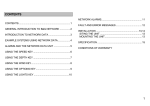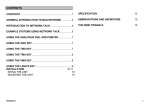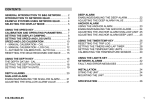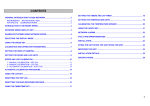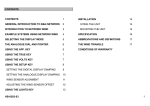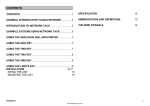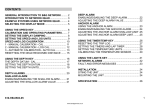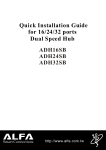Download Network Nav Display User Manual
Transcript
CONTENTS CONTENTS..............................................................................1 USING THE LIGHTS KEY..................................................... 16 GENERAL INTRODUCTION TO B&G NETWORK ...............2 INTRODUCTION TO NETWORK NAV...................................3 NETWORK NMEA INTERFACING RULES ...........................5 SYSTEMS WITH MULTIPLE NAV UNITS..............................5 INTERFACING NETWORK NAV AND PILOT .......................6 EXAMPLE SYSTEMS USING NETWORK NAV ....................7 NETWORK ALARMS............................................................ 17 FAULT AND ERROR MESSAGES ...................................... 19 USING THE COG/SOG KEY...................................................8 SPECIFICATION ................................................................... 22 NAV NMEA 0183 (v1.5) SENTENCE SUMMARY............... 23 USING THE BTW/DTW KEY...................................................9 USING THE OPTIONS KEY..................................................10 INSTALLATION..................................................................... 20 SITING THE UNIT ................................................................ 20 MOUNTING THE UNIT......................................................... 20 GLOSSARY AND ABBREVIATIONS .................................. 24 USING THE SETUP KEY ......................................................11 SELECTING TRUE OR MAGNETIC BEARINGS ................12 SELECTING GREAT CIRCLE OR RHUMB-LINE ...............13 SELECTING UNIVERSAL OR LOCAL TIME.......................14 SELECTING THE NMEA DATA 183/180 .............................15 Network Nav Display User Manual HB-0523-02 1 GENERAL INTRODUCTION TO B&G NETWORK The B&G Network range of instruments is designed for use as individual units or connected together to form an integrated navigational system. A single network cable is used to carry data and power between units. The latest technology and screened cables throughout the Network System ensure the ultimate protection from interference between units and other systems. All Network instruments can be linked to Network PILOT, Network CHART, Network GPS or Network LORAN receivers or via NMEA 0183 (v1.5) to other navigational equipment. INSTRUMENTS NAVIGATIONAL AIDS Network SPEED Network DEPTH Network QUAD Network WIND Network TACK Network DATA Network GPS Network LORAN Network NAV Network CHART AUTOPILOTS COMMUNICATIONS Network PILOT Network VHF Network Nav Display User Manual HB-0523-02 2 INTRODUCTION TO NETWORK NAV NETWORK NAV DISPLAY UNIT The Network NAV unit will act as an on-deck display head of information supplied from any NMEA 0183 (v1.5) compatible position fixer, i.e. GPS, Decca or Loran C. This information is presented on a large back-lit Liquid Crystal Display (LCD). It can be connected directly to the position fixer via its' NMEA interface connector, at the rear of the unit, or as a repeater of information supplied via the network cables from other NAV units when part of an integrated Network System. The NMEA information is translated on to the system network and sent to other Network units, e.g. Cross Track Error (XTE) used by the Network PILOT. The Network NAV unit has an internal alarm buzzer that sounds when an alarm condition is met either on the unit or other Network units in an integrated Network System. The rows of five keys are used to select the displayed information and change the operating parameters of the NAV unit. A brief summary follows: • • • • • COG/SOG BTW/DTW OPTIONS Course Over Ground, Speed Over Ground Bearing to Waypoint, Distance to Waypoint XTE, Course to Steer, Time to Waypoint, Waypoint Identity, Latitude and Longitude SETUP Select data source, magnetic or true bearing, Great Circle or Rhumb distance, Arrival Alarm LIGHTS Three levels of illumination and off. Network Nav Display User Manual HB-0523-02 3 INTRODUCTION TO NETWORK NAV IMPORTANT NOTE It is important to remember that the Network NAV unit is only a display head for any compatible position fixer. Any erratic or positional errors generated by the position fixer due to poor reception, bad satellite constellation or radio beacon chain transitions, will be displayed on the Network NAV and also transmitted to your Network PILOT, if the NAV is part of a system containing an autopilot. It is strongly recommended that an accurate log and positional plot be maintained on a current chart. Before using Network NAV for navigation or supply of data to Network PILOT, check the following: • The position fixer has a compatible NMEA 0183 (v1.5) interface, set-up and connected in accordance with the manufacturers' instructions. • It is switched on and has the correct current position. • The signal and noise levels are manufacturers' recommended levels. within the • The waypoints have been entered correctly, and the waypoint arrival alarm switched on (if it has one). • If using waypoints in a Route or Sail (cruise) Plan, they are entered correctly and the route is enabled. Network Nav Display User Manual HB-0523-02 4 NETWORK NMEA INTERFACING RULES SYSTEMS WITH MULTIPLE NAV UNITS The following rules apply to all Network Systems interfacing with any NMEA 0183 (v1.5) device, e.g. GPS, Decca, Loran C, and Chart Plotters. The Interfacing Rules described previously must be appreciated when using multiple Network NAV units in an Network System. Additionally the following applies: • There can only be one of each of the following position fixer types connected to a Network System: • GPS, Decca and Loran C. • Up to four NAV units may be fitted on a Network System. A NAV unit connected to a position fixer automatically acts as the master unit, any other units NOT connected to position fixers, act as repeaters. • The Network System only allows one source of information for any given NMEA function, transmitted onto the network, e.g. there can be only one XTE supplied from the device selected. • When a Network System contains a Network PILOT, with a display head, and a Network NAV unit, the NMEA input on the Network PILOT display head CANNOT be used. • When the Network PILOT is engaged it is NOT possible to change the source of NMEA information, e.g. it is not possible to change from GPS to Loran C (or Decca) without disengaging the Network PILOT. Network Nav Display User Manual HB-0523-02 • It is possible for a Network System to contain more than one master NAV unit, i.e. one could be connected to a GPS and another to a Decca (or Loran C). When a NAV unit is connected to a position fixer it will declare its type by transmitting a short message on to the system network. GP = GPS, DC = Decca, LC = Loran C. • As the Network rules only allow one source of NMEA information the transmitting master NAV unit connected to it's position fixer, must be selected using the SETUP key. The type of position fixer selected is identified on the LCD (Refer to Using The SETUP Key). • Only one of each type of position fixer is allowed. 5 INTERFACING NETWORK NAV AND PILOT IMPORTANT NOTE • A Network System cannot be constructed where one position fixer is connected via the PILOT display unit NMEA input socket and another via the NAV unit interface. This is an invalid configuration. • If two (different) position fixers are required it is always necessary to use two NAV units. • The Network PILOT Display and Computer unit will use NMEA information from whichever position fixer is selected. • The source of the NMEA information can only selected using a NAV unit. The NAV1 and NAV2 options on the Network PILOT display are no longer valid. • If the NAV unit is to be added to an existing system containing a Network PILOT display, interfaced to an NMEA position fixer via the NMEA input, it will be necessary to transfer the NMEA input from the PILOT display to the NAV unit. Network Nav Display User Manual HB-0523-02 6 EXAMPLE SYSTEMS USING NETWORK NAV Network Nav Display User Manual HB-0523-02 7 USING THE COG/SOG KEY Press the COG/SOG key to cycle through the following options. • COG M Course Over Ground, Magnetic. • SOG KTS Speed Over Ground, SOG is always displayed in Knots KTS. • COG/SOG The LCD will alternatively show COG, then SOG. COG can be displayed as Magnetic M or True T bearings, selected using the SETUP key. If there is no NMEA data available, the unit will display OFF when the COG/SOG button is pressed. Network Nav Display User Manual HB-0523-02 8 USING THE BTW/DTW KEY Press the BTW/DTW to cycle through the following options. • WPB GC M Waypoint Bearing, Great Circle, Magnetic. This is displayed for 5 seconds only. • WPB NAME Then Waypoint Bearing is displayed to the target waypoint, where "NAME" is the first 4 characters of the waypoint name or number, e.g. "JACKSON" would be displayed as "JACK". • WPD GC Waypoint Distance, Great Circle. This is displayed for 5 seconds only. • WPD NAME Then Waypoint Distance is displayed to the target waypoint, where "NAME" is as above. • B/D NAME Bearing and Distance are alternatively displayed to the target waypoint. Waypoint Bearing can be displayed as Magnetic M or True T, selected using the SETUP key. If there is no NMEA data available, the display will show OFF when the BTW/DTW button is pressed. Network Nav Display User Manual HB-0523-02 Waypoint Distance can be displayed as Great Circle GC or Rhumb-line RH, selected using the SETUP key. 9 USING THE OPTIONS KEY Use the OPTIONS key to cycle through the following options. • WP NAME The identifying name or number of the target waypoint, where "NAME" is the first 4 characters of the waypoint name or number, e.g. "JACKSON" would be displayed as "JACK". • TTG HRS Time To Go to the target waypoint in hours. • XTE Cross Track Error, with steering indicator. steer to port, steer to starboard. • CTS M waypoint. Course To Steer, Magnetic M, to the target • VMG NAME Velocity Made Good to "NAME". • LAt/LOn Alternating display of present Latitude and Longitude. • UTC Universal Time Coordinated, can also be selected to display Local Time LT, if available from the position fixer. If there is no NMEA data available, the display will show OFF when the OPTIONS key is pressed. Network Nav Display User Manual HB-0523-02 10 USING THE SETUP KEY The SETUP key allows the Network NAV operating parameters to be set. • BRG M0 The displayed bearing reference, either Magnetic M (factory set), or True T. Press the SETUP key to cycle through the following options. • DIST GC The displayed distance method of calculation, either Great Circle GC (factory set), or Rhumb Line RH. • TIME UTC Selects Universal Time Coordinated UTC (factory set), or Local Time LT. • NMEA 183 NMEA Data selection NMEA 0183 (V1.5) or NMEA 0180. Network Nav Display User Manual HB-0523-02 11 SELECTING TRUE OR MAGNETIC BEARINGS The Network NAV can show bearing in degrees referenced to Magnetic M or True T North. The unit is factory set to Magnetic. The selected reference is for all Nav units on the whole Network System. Press SETUP key until BRG M0 is displayed. Network Nav Display User Manual HB-0523-02 Press ENTER key, the display will flash. Use the S or T keys to change the bearing reference. Press ENTER key to memorise the new setting. 12 SELECTING GREAT CIRCLE OR RHUMB-LINE The Network NAV can show Distances calculated either Great Circle GC or Rhumb-Line RH. The unit is factory set to Great Circle. The selected calculation is for all Nav units on the whole Network System. Press SETUP key until DIST GC is displayed. Network Nav Display User Manual HB-0523-02 Press ENTER key, the display will flash. Use the S or T keys to change the distance display. Press ENTER key to memorise the new setting. 13 SELECTING UNIVERSAL OR LOCAL TIME The Network Nav unit can display time either as Universal Time Coordinated UTC or as Local Time LT. UTC is transmitted by the satellites used for GPS, and has now superseded Greenwich Mean Time GMT. Local Time can be set on some GPS, Decca and LORAN C receivers, check your owner's manual. Press SETUP key until TIME UTC is displayed. Network Nav Display User Manual HB-0523-02 Press ENTER key, the display will flash. Use the S or T keys to change the displayed time. Press ENTER key to memorise the new setting. 14 SELECTING THE NMEA DATA This selection allows the NAV to translate early NMEA device output sentences for display. Modern equipment uses NMEA 0183 output sentences, early equipment may have used NMEA 0183. Consult the user manual for your equipment to determine the correct setting Press SETUP key until NMEA 183 is displayed. Network Nav Display User Manual HB-0523-02 Press ENTER key, the display will flash. Use the S or T keys to change the NMEA data type. Press ENTER key to memorise the NMEA data type. 15 USING THE LIGHTS KEY The Network NAV Display unit has 3 levels of illumination and off, controlled by the LIGHTS key. It also changes the illumination level of the key legends. The LIGHTS key is always illuminated so even in complete darkness the key can be located. Network Nav Display User Manual HB-0523-02 16 NETWORK ALARMS DEPTH ALARM DISPLAY The Network NAV unit has an internal buzzer that will sound when an alarm condition is met on a Network unit that has alarm functions i.e. Network DEPTH and Network QUAD for depth alarms and Network PILOT for Watch Alarm and Off Course alarms. The unit will also display which alarm is activated. To silence the internal alarm and return the display to normal operation press any of the five keys. WAYPOINT ARRIVAL Depth alarms can be set for the following: • • • • Shallow water Deep water Anchor Watch Check your Network DEPTH or QUAD unit to see which alarm is activated. The Network Waypoint Arrival alarm is activated when an alarm signal is sent from the position fixer as the boat approaches the target waypoint that is currently selected. It will only sound if the arrival alarm is set and enabled on the position fixer. Network Nav Display User Manual HB-0523-02 17 NETWORK ALARMS NETWORK PILOT ALARM DISPLAYS OFF-COURSE ALARM WATCH ALARM The Watch Alarm is a count-down timer which is activated at the end of the preset count-down period. The display alternates between the messages above. Network Nav Display User Manual HB-0523-02 The Off Course alarm is activated when the boat deviates off course by a preset amount. The display alternates between the messages above. 18 FAULT AND ERROR MESSAGES UNIT INTERNAL ERRORS NETWORK PILOT FAULT DISPLAY If Network PILOT should have a fault condition the autopilot computer unit will send a message to all other Network Display Units. The Network NAV unit will alternately display the following message, the actual fault will have to read from the Network PILOT Display unit. In the unlikely event that your Network NAV unit should develop an internal error, the unit will sound its alarm continuously and the display will show an error number. Pressing the keys will not silence this alarm. In some cases the fault can be cleared by switching off the instruments at the supply, waiting a few moments and then switching on again. If this does not clear the fault the error number should be recorded. Switch off the supply and disconnect the faulty unit. Return it with the error number to your dealer for servicing. Network Nav Display User Manual HB-0523-02 19 INSTALLATION MOUNTING THE UNIT The display heads are supplied with a clip-in mounting bracket that allows for easy installation, access from behind is not necessary to secure the unit in place. However to prevent theft and permanently fix the unit in position, locking studs and thumb nuts are supplied. Use the cutting template supplied to mark the centres of the holes for the self-tapping screw, the fixing stud holes and the mounting bracket. SITING THE UNIT All Network Instruments are designed for mounting on or below deck. A mounting position should be selected where they are: • • • • Easy to read by the helmsman On a smooth and flat surface At least 100mm (4") from a compass Accessible from behind for fitting locking studs if required. Network Nav Display User Manual HB-0523-02 • The template allows 4mm (5/32") between adjacent units for the sun cover, increase this distance if required to maximum of 60mm (2 3/8") between units or 180mm (3 1/8") between centres. For greater distances between units extension cables are available. • Use a 70mm (2 3/4") diameter hole-cutter for the mounting bracket hole. • Use a 2.9mm for the self-tapping screw holes. • Use a 5mm (3/32") drill for the locking stud holes. • Secure the mounting bracket to the bulkhead with the self-tapping screws supplied • Fit the rubber-sealing gasket around the mounting bracket. • Screw the locking studs into the back of the display head (if required). • Carefully pass the cable tails through the mounting bracket hole, connect the cables to the main units. • Clip the display head into the mounting bracket. • Secure the instrument with the thumb nuts supplied. 20 INSTALLATION Network Nav Display User Manual HB-0523-02 21 SPECIFICATION PHYSICAL PARAMETERS ELECTRICAL Construction Window Display Power Supply Operating Current Protection Dimensions Weight High impact ABS plastic Acrylic Back-lit Liquid Crystal Display: Large Digits: 28.6mm 1.12" Small Digits: 11.5mm 0.45" 110 x 110 x 25.4mm 4 x 4 x 1" Requires 65mm 2.6" depth behind bulkhead for display barrel 0.3 kg 0.66lbs ENVIRONMENTAL Operating Temp -10 to +550C @ 93%RH +14 to +1310F @ 93%RH Storage Temp -25 to +700C @ 95%RH -13 to +1580F @ 93%RH Humidity Up to 95%RH Sealing Fully sealed front, suitable for bulkhead cockpit mounting. Vented barrel to prevent condensation. Network Nav Display User Manual HB-0523-02 12V DC nominal (10V to 16V) 40mA typical, 100mA illuminated Connect via external fuse or circuit breaker. CABLES AND CONNECTIONS Connection to adjacent units is via cable tails fitted with either a plug or a socket. Extension cables are available from your dealer. The cable tails carry power and NMEA data between units. ALARM Internal audible alarm 22 NAV NMEA 0183 (v1.5) SENTENCE SUMMARY NMEA INPUT SENTENCE (NETWORK DECODED DATA) NMEA OUTPUT SENTENCES $IDAAM $IDAPA $IDAPB $IIHDM $IIVHW $IIDBT $IIVWR $IIMTW $IDBWC $IDBWR $IDGLL $IDGGA $IDGLP $IDRMA $IDRMB $IDRMC $IDVHW $IDVTG $IDWCV $IDXTE $IDZTG Arrival alarm, waypoint i.d. XTE, arrival alarm, waypoint i.d. XTE, bearing to waypoint, course to steer, arrival alarm, waypoint i.d. Bearing and distance to waypoint, great circle measured, waypoint i.d. Bearing and distance to waypoint, rhumb measured, waypoint i.d. Latitude, Longitude. Latitude, Longitude (GPS only). Latitude, Longitude, waypoint id (Loran). Latitude, Longitude, SOG, COG, variation (Loran). XTE, bearing and distance to waypoint, VMG to waypoint, waypoint i.d. Latitude, Longitude, SOG, COG, variation, (GPS). Boat speed. Actual track and ground speed. Velocity to Waypoint, waypoint identity. Cross track error. Time to waypoint. Network Nav Display User Manual HB-0523-02 Heading, magnetic. Water speed and heading. Depth below transducer. Apparent wind angle and speed Sea temperature, Celsius. NOTE: "ID" is any one of the following NMEA devices GP=GPS, DC=Decca, LC=Loran C. 23 GLOSSARY OF TERMS AND ABBREVIATIONS BEARING The direction from one point to another. GREAT CIRCLE The shortest distance between two points on a globe. RHUMB-LINE The shortest distance between two points (straight-line). AR B/D BRG BTW COG CTS D DIST DTW E GC GMT GPS HRS KTS LAt LOn Arrival (alarm) Bearing/Distance (to waypoint) Bearing Bearing to waypoint, (waypoint bearing). Course Over Ground. Course to Steer. Demo (display type) Distance Distance to waypoint, (waypoint distance). East Great Circle. Greenwich Mean Time. Now superseded by UTC. Global Positioning System. Hours. Knots, 1 Nautical mile per hour. Latitude. Longitude. Network Nav Display User Manual HB-0523-02 LT M N NMEA RH S T TTG UTC VMG W WP WPB WPD XTE Local Time. Magnetic (bearing reference). Normal (display type), North when used with LAt or LOn National Marine Equipment Association of America. Rhumb-line. South True (bearing reference). Time to Go (to waypoint). Universal Time Co-ordinated. Supersedes GMT. Greenwich Mean Time Velocity Made Good. West Waypoint Waypoint Bearing Waypoint Distance. Cross Track Error. 24

























